

Length Problems
Length word problems.
Example 1: A 57-foot wood is cut into two pieces. One piece is 3 feet less than twice the length of the other. What is the length of the longer piece of wood?
Just like in any other kind of word problem, the first step that we have to do is to identify what important pieces of information are given to us in the problem.
In this example, we are told how long the wood is (57 feet) as well as the measurement for one of the two pieces. The given piece is defined using the other piece so let’s call it the second piece and assign the variable [latex]\large{x}[/latex] to represent the first piece. Note that the measurement of the first piece is currently unknown.
Since the second piece is 3 feet less than twice the length of the first piece , then it can be algebraically expressed as [latex]2{\large{x}} – 3[/latex].
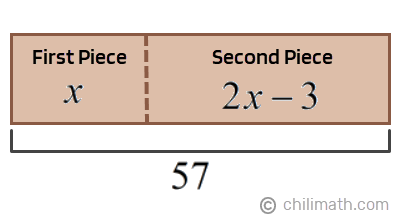
So we have,
- Total Length: [latex]57[/latex]
- First Piece: [latex]\large{x}[/latex]
- Second Piece: [latex]2{\large{x}}-3[/latex]
Now that we have all this information, let’s go ahead and solve for [latex]\large{x}[/latex] so we can find the measurements for both pieces.
Luckily for length word problems, we don’t have to remember any particular formula. We simply have to set up our equation where we add all the pieces on one side and the total length of the object on the other.
First Piece + Second Piece = Total Length
Let’s solve for [latex]\large{x}[/latex].

Going back to our original problem, it asks us for the measurement of the longer piece. At this point, we only know that the first piece is 20 feet long. In order to determine which one is longer, we’ll use the value of [latex]\large{x}[/latex] to also find the length of the second piece. Therefore,
- First Piece = [latex]20[/latex]
- Second Piece = [latex]2x-3[/latex] = [latex]2({\color{red}20}) – 3[/latex] = [latex]40-3[/latex] = [latex]37[/latex]
Answer: The longer piece of wood is 37 feet long.
Before we move on to the next problem, let’s do a quick check to make sure that we got the correct answers. We were told that the total length of the wood is 57 feet. So we’ll check if the measurements of our pieces indeed sum up to 57.
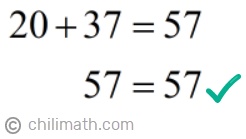
And it did! With this quick check, we were able to verify that the measurements we got for both pieces are correct.
Example 2: A wire is cut into two pieces. The shorter piece is 1 meter more than half the longer piece. The length of the wire is 28 meters. What is the measure of the shorter piece?
This next example is quite similar to the first one. Right away, we can see that the shorter wire is defined using the length of the longer wire. The length of the longer wire at this point is unknown, so let’s use the variable [latex]L[/latex] to represent it.
So what do we have?
- Total Length: [latex]28[/latex]
- Longer Piece: [latex]L[/latex]
- Shorter Piece: 1 meter more than half the longer piece → [latex]{\Large{{L \over 2}}} + 1[/latex]
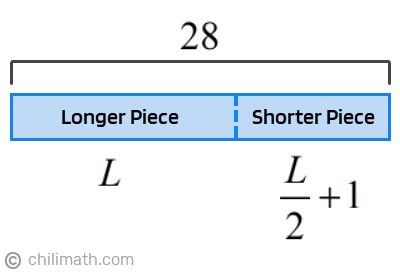
Let’s now proceed to solve for [latex]L[/latex] by adding the longer piece and the shorter piece then set it equal to the total length of the wire. So we have,
Longer Piece + Shorter Piece = Total Length
![problem solving involving length L+[(L/2)+1]=28 → L=18](https://www.chilimath.com/wp-content/uploads/2020/11/ex2_solveforL.png)
Great! We now know that our longer piece is 18 feet long. But since the problem is asking for the measurement of the shorter piece, we’ll use the value of [latex]L[/latex] which is [latex]18[/latex], to also find out how long the shorter piece is.
- Longer Piece: [latex]18[/latex]
- Shorter Piece: [latex]{\Large{{L \over 2}}} + 1[/latex] = [latex]{\Large{{{\color{red}18} \over 2}}} + 1[/latex] = [latex]9+1[/latex] = [latex]10[/latex]
Answer: The length of the shorter piece of wire is 10 meters.
To verify, let’s add both of the pieces to see if they equal the total length of the wire which is 28 meters.
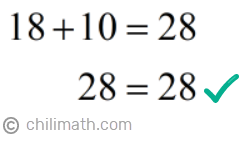
Example 3: A piece of board is cut into three segments. The second segment is 3 inches more than the first segment. The third segment is twice as long as the second segment. If the board is 117 inches, what is the length of the third segment?
Here we have an object that is divided into three. As you can see, the 2nd segment is described in terms of the measurement of the 1st segment while the 3rd segment is defined using the length of the 2nd segment. How about the 1st segment? Well, this segment is unknown right now so let’s represent it with the variable [latex]F[/latex].
Looking back at our word problem, here are the information that we have so far.
- Total Length: 117
- First Segment: [latex]F[/latex]
- Second Segment: 3 inches more than the 1st segment → [latex]F+3[/latex]
- Third Segment: twice as long as the 2nd segment → [latex]2(F+3)[/latex]
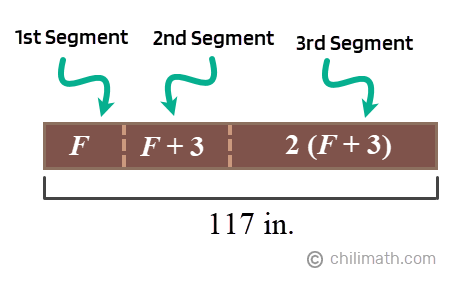
We’ll proceed by setting up our equation and solving for [latex]F[/latex].
1st Segment + 2nd Segment + 3rd Segment = Total Length
![problem solving involving length F+(F+3)+[2(F+3)]=117 → F=27](https://www.chilimath.com/wp-content/uploads/2020/11/ex3_solveforF.png)
As you know, we used the variable [latex]F[/latex] to represent the 1st segment of the board. Therefore, we can say that the 1st segment is 27 in. long. Since our problem is asking us to find how long the 3rd segment is (which is currently defined using the 2nd segment), this means that we also have to find the measurements of both the 2nd and 3rd segments.
- 1st Segment: [latex]27[/latex]
- 2nd Segment: [latex]F+3[/latex] = [latex]{\color{red}27}+3[/latex] = [latex]30[/latex]
- 3rd Segment: [latex]2(F+3)[/latex] = [latex]2({\color{red}30})[/latex] = [latex]60[/latex]
Answer: The length of the third segment is 60 inches.
Let’s do a quick check if all the segments, when added, will give us the total length of the board which is 117 inches.
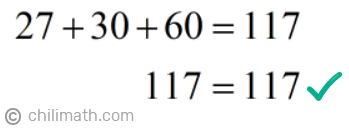
Example 4: A stick is broken into three pieces. The second piece is twice the length of the first piece. The third piece is the average of the first piece and the second piece. The length of the stick is 207 centimeters. Which among the pieces has a measurement that is between the shortest and the longest piece and what is its dimension?
This problem is quite interesting and I must say, is packed with a lot of information. However, do not let that overwhelm you. As long as you continue to follow the steps that we’ve been doing in our previous examples, you’ll realize that this problem isn’t as hard as it looks.
What details are given to us?
- Total Length: [latex]207[/latex]
- 1st Piece: [latex]\large{x}[/latex]
- 2nd Piece: twice the length of the first piece → [latex]2{\large{x}}[/latex]
- 3rd Piece: the average of the first piece and the second piece → [latex]\Large{{{x + 2x} \over 2}}[/latex]
As you can see, we used the variable [latex]\large{x}[/latex] to stand for the first piece which is currently unknown, because it is not defined using the second piece nor the third piece.
Our next step is to solve for [latex]\large{x}[/latex].
![problem solving involving length x+2x+[(x+2x)/2]=207 → x=46](https://www.chilimath.com/wp-content/uploads/2020/11/ex4_solveforx.png)
Using the value of [latex]\large{x}[/latex], let’s find out how long each piece of the broken stick is.
- 1st Piece: [latex]46[/latex]
- 2nd Piece: [latex]2x[/latex] → [latex] 2({\color{red}46})[/latex] → [latex]92[/latex]
- 3rd Piece: [latex]\Large{{{x + 2x} \over 2}}[/latex] → [latex]\Large{{{{\color{red}46} + {\color{red}92}} \over 2}}[/latex] → [latex]\Large{{{138} \over 2}}[/latex] → [latex]69[/latex]
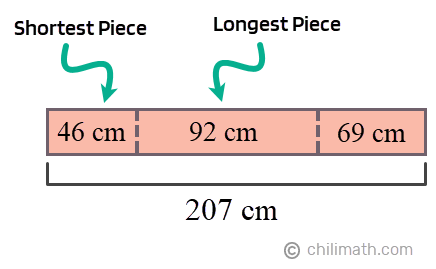
Going back to our original question…which among the pieces has a measurement that is between the shortest and the longest piece, and what is its dimension?
Answer: The third piece of the stick which is 69 centimeters long has the measurement that is between the shortest and the longest pieces.
This time, I’ll leave it up to you to check if the measurements that we got for the three pieces indeed sum up to 207 cm.
Example 5: A rope is cut into two pieces. If the first piece is added to the second piece, the sum is 25 yards. In addition, twice the first piece plus the second piece equals 40 yards. What is the measure of the shorter piece?
Now this problem is a little tricky. If you notice, none of the two pieces are described in terms of the other.
To start, let us identify the pieces of information that are given in the problem and translate each statement algebraically into an equation.
Let’s use the variables [latex]F[/latex] and [latex]S[/latex] to represent the first piece and second piece, respectively.
1) If the first piece is added to the second piece, the sum is 25 yards .
[latex]F + S = 25[/latex]
2) Twice the first piece plus the second piece equals 40 yards .
[latex]2F + S = 40[/latex]
Going through both statements, we are able to come up with two equations.
- Equation 1: [latex]F + S = 25[/latex]
- Equation 2: [latex]2F + S = 40[/latex]
As you can see, we are dealing with two equations with two unknowns, [latex]F[/latex] and [latex]S[/latex] which means we will be solving systems of linear equations with two variables.
Our next step is to use Equation 1 to express the second piece ([latex]S[/latex]) in terms of the first piece ([latex]F[/latex]). Then we can substitute the expression that we get into Equation 2. In doing so, we will have a multi-step equation with only [latex]F[/latex] as the only variable instead of having both.
Note that we can also do the other way around. That is, expressing the first piece in terms of the second piece. However, for this example, we’ll solve for the variable [latex]S[/latex].
We’ll do this step-by-step so it’s easy to understand and follow.
1) Start with Equation 1. Solve for [latex]S[/latex].
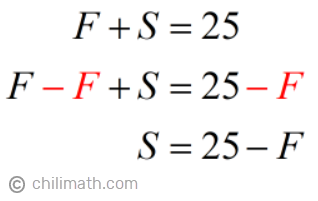
2) Next, substitute the expression of [latex]S[/latex] into Equation 2.

Remember that the variable [latex]F[/latex] stands for the first piece. Therefore, we can now say that the first piece is 15 yards. However, since our problem is asking us for the measure of the shorter piece, we also need to find how long the second piece is, so we can compare and identify between the two (1st piece and 2nd piece) which one is shorter.
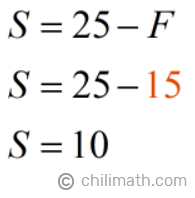
- First Piece: [latex]15[/latex] yards
- Second Piece: [latex]10[/latex] yards
We now know that the second piece then is the shorter piece. Let’s go ahead and answer the original question.
Answer: The shorter piece is 10 yards long.
In order to verify that our answers are correct, we’ll substitute the values of [latex]F[/latex] and [latex]S[/latex] into both Equations 1 and 2. In doing so, we’ll be able to prove that the statements given in the word problem are true.
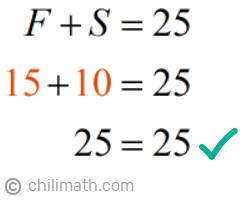
Example 6: A piece of wood is cut into two. The sum of the first piece and the second piece is 71 inches. The difference of 4 times the first piece and twice the second piece is 20 inches. What is the measure of the longer piece?
This one is similar to what we just discussed in Example 5. Since neither of the two pieces is defined in terms of the other piece, let’s look at the important pieces of information that are given to us in the problem.
Like our previous example, we’ll examine each of the statements first then translate them algebraically.
Let [latex]\large{x}[/latex] be the first piece and [latex]\large{y}[/latex] be the second piece.
1) The sum of the first piece and the second piece is 71 inches .
Equation 1: [latex]\large{x + y = 71}[/latex]
2) The difference of 4 times the first piece and twice the second piece is 20 inches .
Equation 2: [latex]\large{4x – 2y = 20}[/latex]
Now that we have our two equations, let’s express the first piece ([latex]\large{x}[/latex]) in terms of the second piece ([latex]\large{y}[/latex]).
- Using Equation 1, let’s solve for [latex]\large{x}[/latex]. So we have,
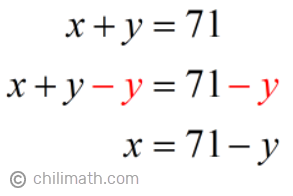
- Substitute the expression of [latex]\large{x}[/latex] into Equation 2.
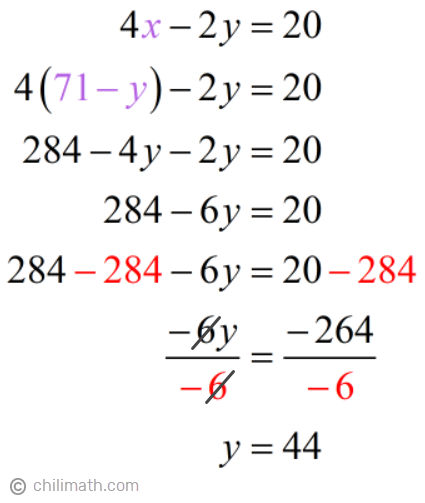
Looking back at our original problem, it’s asking us for the measure of the longer piece. At this point, we know that the second piece ([latex]\large{y}[/latex]) is 44 in. long. But is it the longer piece? Well, we don’t know yet. We have to know how long the first piece ([latex]\large{x}[/latex]) as well so we can determine which one is longer.
We already have our expression for [latex]\large{x}[/latex], so all we need to do is substitute the value of [latex]\large{y}[/latex] into the expression.
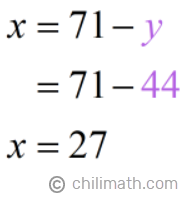
Okay, let’s do a recap. The measurements for our two pieces are:
- First Piece: [latex]27[/latex] in.
- Second Piece: [latex]44[/latex] in.
Perfect! Now we know that the second piece is longer than the first piece.
Going back to the original question, what is the measure of the longer piece?
Answer: The longer piece is 44 inches long.
Word Problems on Measuring Length
We will discuss here how to solve the word problems on measuring length (i.e. addition and subtraction).
Addition and subtraction in meters and centimeters is done in the similar way as in the case of ordinary numbers.
(i) When we add meters and meters the sum is in meters and when we add centimeters and centimeters the sum is in centimeters. Here centimeters are written as two digit number.
(ii) When we subtract meters from meters the difference is in meters and when we subtract centimeters from centimeters the difference is in centimeters. Here centimeters are written as two digit number.
Solved word problems on measuring length:
1. Sita is 1 m 30 cm tall and her sister Rita is 1m 60 cm tall. Who is taller and by how much?
|
|
1 50
|
Rita is taller by 1 m 50 cm - 1 m 30 cm = 20 cm
2. Maria purchased 24 m 25 cm rope and Nancy purchased 17 m 15 cm rope. What is the total length of ropes both of them purchased?
Length of ropes purchased by Maria = 24 m 25 cm
Length of ropes purchased by Nancy = 17 m 15 cm
Total length of ropes purchased by them = 24 m 25 cm + 17 m 15 cm
= 41 m 40 cm
3. Subtract 20 m 15 cm from 36 m 95 cm.
First arrange meters and centimeters in columns.
Then subtract 15 cm from 95 cm.
| 95 cm - 15 cm = 80 cm Write it in centimeter column.
Then subtract 20 m from 36 m.
36 m - 20 m = 16 m Write this in metre column. The answer is 16 m 80 cm. | m cm
36 95
-
|
4. Mary is 1 m 15 cm tall. Her friend Larry is 1 m 30 cm tall. Who is taller and by how much?
| The height of Mary = 1 m 15 cm
The height of Larry = 1 m 30 cm
Difference between their height = 1 m 30 cm - 1 m 15 cm = 15 cm Larry is taller by 15 cm. |
1 30 -
|
5. Aaron bought 9 m 75 cm of cloth. He used 2 m 30 cm from it. How much cloth is left?
Total length of cloth Aaron bought = 9 m 75 cm.
Length of cloth he used = 2 m 30 cm.
Therefore, the length of cloth left = 9 m 75 cm - 2 m 30 cm
= 7 m 45 cm
Measurement of Length:
Standard Unit of Length
Conversion of Standard Unit of Length
Addition of Length
Subtraction of Length
Addition and Subtraction of Measuring Length
Addition and Subtraction of Measuring Mass
Addition and Subtraction of Measuring Capacity
3rd Grade Math Worksheets
3rd Grade Math Lessons
From Word Problems on Measuring Length to HOME PAGE
Didn't find what you were looking for? Or want to know more information about Math Only Math . Use this Google Search to find what you need.
New! Comments
|
What’s this? | Facebook X Pinterest WhatsApp Messenger |
- Preschool Activities
- Kindergarten Math
- 1st Grade Math
- 2nd Grade Math
- 3rd Grade Math
- 4th Grade Math
- 5th Grade Math
- 6th Grade Math
- 7th Grade Math
- 8th Grade Math
- 9th Grade Math
- 10th Grade Math
- 11 & 12 Grade Math
- Concepts of Sets
- Probability
- Boolean Algebra
- Math Coloring Pages
- Multiplication Table
- Cool Maths Games
- Math Flash Cards
- Online Math Quiz
- Math Puzzles
- Binary System
- Math Dictionary
- Conversion Chart
- Homework Sheets
- Math Problem Ans
- Free Math Answers
- Printable Math Sheet
- Funny Math Answers
- Employment Test
- Math Patterns
- Link Partners
- Privacy Policy
| E-mail Address | |
| First Name | |
| to send you Math Only Math. |
Recent Articles
Fraction | a part of a whole number | numerator | denominator |example.
Jul 09, 24 02:25 AM
5th Grade Math Problems | Table of Contents | Worksheets |Free Answers
Jul 09, 24 01:39 AM
Types of Three-Dimensional Shapes | 3D Shapes | Definition, Properties
Jul 09, 24 12:41 AM
6th Grade Math Practice | Table of Contents | Worksheets | Videos Math
Jul 08, 24 01:38 AM
Regular and Irregular Polygons | Definitions |Examples|Questions & Ans
Jul 07, 24 02:57 PM
© and ™ math-only-math.com. All Rights Reserved. 2010 - 2024.
Solving problems involving height and length
Part of Maths Measuring Year 2
Watch: Estimating and measuring
This video can not be played
To play this video you need to enable JavaScript in your browser.
Fin and Snoot calculate the length of their new cars, using feet, centimeters and meters.
Video Transcript Video Transcript
NARRATOR: Hello Snoot, what’s that you’re driving?
ALIEN: (Alien language)
NARRATOR: I see, you hired a go-kart from the intergalactic market.
Hello Finn.
NARRATOR: What an impressive car. On Earth, that’s called a limousine. It’s a lot longer than Snoot’s go-kart isn’t it?
How long is it exactly?
NARRATOR: I’ve got an idea, you can estimate the length in steps.
The go-kart is ten steps in length and the limousine is 30 steps in length.
30 is three times ten. That makes the limousine three times longer than the go-kart.
NARRATOR: I know Snoot. Counting things out in steps isn’t very accurate, it just gives you an estimate of how long things are.
If you want to know exactly, you’ll have to use a tape measure.
On Earth we use centimetres to measure quite small lengths, like the width of a tire, or the diameter of a wheel.
And we use metres to measure longer lengths, like the length of a car.
ALIENS: Ah ha!
NARRATOR: So, according to the tape measure, Snoot’s go-kart is two metres long, and Finn’s limousine is six metres long.
Six is three times two, so your estimates were right!
The limousine is three times longer than the go-kart.
Hello Plimble.
ALIEN: Hello.
NARRATOR: I see you hired a monster truck. I think we are going to need a bigger tape measure.

More on Measuring
Find out more by working through a topic
Measuring mass in grams
- count 6 of 10
Measuring mass in kilograms
- count 7 of 10
Measuring in millilitres
- count 8 of 10
Measuring in litres
- count 9 of 10

Reading & Math for K-5
- Kindergarten
- Learning numbers
- Comparing numbers
- Place Value
- Roman numerals
- Subtraction
- Multiplication
- Order of operations
- Drills & practice
- Measurement
- Factoring & prime factors
- Proportions
- Shape & geometry
- Data & graphing
- Word problems
- Children's stories
- Leveled Stories
- Sentences & passages
- Context clues
- Cause & effect
- Compare & contrast
- Fact vs. fiction
- Fact vs. opinion
- Main idea & details
- Story elements
- Conclusions & inferences
- Sounds & phonics
- Words & vocabulary
- Reading comprehension
- Early writing
- Numbers & counting
- Simple math
- Social skills
- Other activities
- Dolch sight words
- Fry sight words
- Multiple meaning words
- Prefixes & suffixes
- Vocabulary cards
- Other parts of speech
- Punctuation
- Capitalization
- Narrative writing
- Opinion writing
- Informative writing
- Cursive alphabet
- Cursive letters
- Cursive letter joins
- Cursive words
- Cursive sentences
- Cursive passages
- Grammar & Writing
Breadcrumbs
- Word Problems
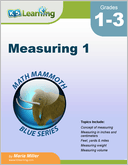
Download & Print Only $5.40
Length word problems
Inches, feet, cm, m.
These grade 3 word problem worksheets deal with simple addition, subtraction and comparison of lengths. The first 3 worksheets use customary units of inches and feet; the last 3 worksheets use metric units. No conversion of units is required.

These worksheets are available to members only.
Join K5 to save time, skip ads and access more content. Learn More
More word problem worksheets
Explore all of our math word problem worksheets , from kindergarten through grade 5.
What is K5?
K5 Learning offers free worksheets , flashcards and inexpensive workbooks for kids in kindergarten to grade 5. Become a member to access additional content and skip ads.
Our members helped us give away millions of worksheets last year.
We provide free educational materials to parents and teachers in over 100 countries. If you can, please consider purchasing a membership ($24/year) to support our efforts.
Members skip ads and access exclusive features.
Learn about member benefits
This content is available to members only.
- Forgot Password?
Length - practice problems
Number of problems found: 3078.
- all math problems 18996
- physical quantity 6461
- length 3078
- unit conversion 687
- velocity 329
- motion problems 325
- triangle 321
- equation 286
- expression of a variable from the formula 270
- right triangle 263
- area of a shape 232

- New math problems
- Popular math problems
- Harder math problems
- The easiest word problems

Practice Length Measurement Problems
To solve length measurement problems , we need to have various factors in mind: the unit of measurement used, conversion exercises, and the understanding of how to use different measuring units. In this post, we’ll present different exercise types that’ll help us understand these concepts.
Unit of Measure Used to Express the Information
In problems that deal with length measurements, it’s extremely important to always have the unit that is used in mind. A length expressed in km is not the same thing as a length expressed in cm.
To stress the importance of this concept, it’s important to do exercises that make us approximate the measuring unit according to the length of the object that is being measured.
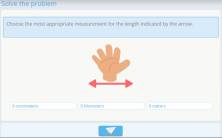
This is an example of a problem where we work on the approximation of measurements according to the unit in use.
These measurements don’t have to be exact because the exact measurement is not what we’re after. What’s important is that the student understands that, in this case, a palm can’t be measured in kilometers or meters, but rather, in the appropriate unit, or centimeters.
Understanding the Use of Different Measuring Units
It’s also important to show students the practicality of this lesson with problems where they have to apply what they’ve learned.
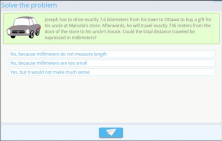
This is how we can teach the practicality of expressing each situation according to its corresponding unit of measure. It also helps you be more attentive to the differences so you can go ahead with changing the units necessary in order to solve the problem.
Conversion Length Measurement Problems
The problems that we’ve made for the application on unit conversion have to be realistic so that they teach students how to apply what they’ve learned in real life.
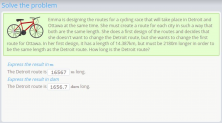
So, wrapping up, we maintain that in order to do exercises that require students to know length units, we must continue the learning process with different concepts that are implied by this topic in a progressive manner:
- The practicality of using different length and measuring unit multiples and submultiples.
- Making examples out of different real-life situations.
- Applying what was learned to real-life situations that require unit conversions. If you thought this post was interesting, remember that you can find more like this at Smartick
Learn More:
- Learn to Solve Measuring Problems
- Conversion Capacity Problems in the Metric System
- Learn More about Measurements of Length
- Dimensions: Length, Width, and Height of an Object
- Review of All Units of Measurements
- 15 fun minutes a day
- Adapts to your child’s level
- Millions of students since 2009

- Recent Posts
- The Language of Functions and Graphs - 07/01/2024
- Educational Technology: The Christodoulou Test - 05/06/2024
- Multiplication Activities in Smartick - 04/09/2024
Add a new public comment to the blog: Cancel reply
The comments that you write here are moderated and can be seen by other users. For private inquiries please write to [email protected]
Your personal details will not be shown publicly.
I have read and accepted the Privacy and Cookies Policy

Or search by topic
Number and algebra
- The Number System and Place Value
- Calculations and Numerical Methods
- Fractions, Decimals, Percentages, Ratio and Proportion
- Properties of Numbers
- Patterns, Sequences and Structure
- Algebraic expressions, equations and formulae
- Coordinates, Functions and Graphs
Geometry and measure
- Angles, Polygons, and Geometrical Proof
- 3D Geometry, Shape and Space
- Measuring and calculating with units
- Transformations and constructions
- Pythagoras and Trigonometry
- Vectors and Matrices
Probability and statistics
- Handling, Processing and Representing Data
- Probability
Working mathematically
- Thinking mathematically
- Mathematical mindsets
- Cross-curricular contexts
- Physical and digital manipulatives
For younger learners
- Early Years Foundation Stage
Advanced mathematics
- Decision Mathematics and Combinatorics
- Advanced Probability and Statistics
Resources tagged with: Length/distance
There are 58 NRICH Mathematical resources connected to Length/distance , you may find related items under Measuring and calculating with units .
Car Journey
This practical activity involves measuring length/distance.
Can You Do it Too?
Try some throwing activities and see whether you can throw something as far as the Olympic hammer or discus throwers.
Olympic Measures
These Olympic quantities have been jumbled up! Can you put them back together again?
Now and Then
Look at the changes in results on some of the athletics track events at the Olympic Games in 1908 and 1948. Compare the results for 2012.
Olympic Starters
Look at some of the results from the Olympic Games in the past. How do you compare if you try some similar activities?
The Animals' Sports Day
One day five small animals in my garden were going to have a sports day. They decided to have a swimming race, a running race, a high jump and a long jump.
A group of children are discussing the height of a tall tree. How would you go about finding out its height?
Place Your Orders
Can you rank these sets of quantities in order, from smallest to largest? Can you provide convincing evidence for your rankings?
Discuss and Choose
This activity challenges you to decide on the 'best' number to use in each statement. You may need to do some estimating, some calculating and some research.
Order, Order!
Can you place these quantities in order from smallest to largest?
Speed-time Problems at the Olympics
Have you ever wondered what it would be like to race against Usain Bolt?
These pictures were made by starting with a square, finding the half-way point on each side and joining those points up. You could investigate your own starting shape.
A Question of Scale
Use your skill and knowledge to place various scientific lengths in order of size. Can you judge the length of objects with sizes ranging from 1 Angstrom to 1 million km with no wrong attempts?
All in a Jumble
My measurements have got all jumbled up! Swap them around and see if you can find a combination where every measurement is valid.
Sizing Them Up
Can you put these shapes in order of size? Start with the smallest.
Up and Across
Experiment with the interactivity of "rolling" regular polygons, and explore how the different positions of the dot affects its vertical and horizontal movement at each stage.
How Far Does it Move?
Experiment with the interactivity of "rolling" regular polygons, and explore how the different positions of the red dot affects the distance it travels at each stage.
Take Your Dog for a Walk
Use the interactivity to move Pat. Can you reproduce the graphs and tell their story?
The Man is much smaller than us. Can you use the picture of him next to a mug to estimate his height and how much tea he drinks?
Rolling Around
A circle rolls around the outside edge of a square so that its circumference always touches the edge of the square. Can you describe the locus of the centre of the circle?
Four on the Road
Four vehicles travel along a road one afternoon. Can you make sense of the graphs showing their motion?
Uniform Units
Can you choose your units so that a cube has the same numerical value for it volume, surface area and total edge length?
Where Am I?
From the information you are asked to work out where the picture was taken. Is there too much information? How accurate can your answer be?
Lengthy Journeys
Investigate the different distances of these car journeys and find out how long they take.
Working with Dinosaurs
This article for teachers suggests ways in which dinosaurs can be a great context for discussing measurement.
Swimmers in opposite directions cross at 20m and at 30m from each end of a swimming pool. How long is the pool ?

Triangle Relations
What do these two triangles have in common? How are they related?
A Scale for the Solar System
The Earth is further from the Sun than Venus, but how much further? Twice as far? Ten times?
Flight Path
Use simple trigonometry to calculate the distance along the flight path from London to Sydney.
Chippy's Journeys
Chippy the Robot goes on journeys. How far and in what direction must he travel to get back to his base?
Can you prove that the sum of the distances of any point inside a square from its sides is always equal (half the perimeter)? Can you prove it to be true for a rectangle or a hexagon?
Measure for Measure
This article, written for students, looks at how some measuring units and devices were developed.
Eclipses of the Sun
Mathematics has allowed us now to measure lots of things about eclipses and so calculate exactly when they will happen, where they can be seen from, and what they will look like.
A paradox is a statement that seems to be both untrue and true at the same time. This article looks at a few examples and challenges you to investigate them for yourself.
How can the school caretaker be sure that the tree would miss the school buildings if it fell?
N Is a Number
N people visit their friends staying N kilometres along the coast. Some walk along the cliff path at N km an hour, the rest go by car. How long is the road?
The Dodecahedron Explained
What is the shortest distance through the middle of a dodecahedron between the centres of two opposite faces?
Do You Measure Up?
A game for two or more players that uses a knowledge of measuring tools. Spin the spinner and identify which jobs can be done with the measuring tool shown.
Alice's mum needs to go to each child's house just once and then back home again. How many different routes are there? Use the information to find out how long each road is on the route she took.
The Hare and the Tortoise
In this version of the story of the hare and the tortoise, the race is 10 kilometres long. Can you work out how long the hare sleeps for using the information given?
A Flying Holiday
Follow the journey taken by this bird and let us know for how long and in what direction it must fly to return to its starting point.
Watching the Wheels Go 'round and 'round
Use this information to work out whether the front or back wheel of this bicycle gets more wear and tear.
Nirmala and Riki live 9 kilometres away from the nearest market. They both want to arrive at the market at exactly noon. What time should each of them start riding their bikes?
Practice Run
Chandrika was practising a long distance run. Can you work out how long the race was from the information?
A Rod and a Pole
A lady has a steel rod and a wooden pole and she knows the length of each. How can she measure out an 8 unit piece of pole?
How many centimetres of rope will I need to make another mat just like the one I have here?
Walk and Ride
How far have these students walked by the time the teacher's car reaches them after their bus broke down?
On the Road
Four vehicles travelled on a road. What can you deduce from the times that they met?
Use your hand span to measure the distance around a tree trunk. If you ask a friend to try the same thing, how do the answers compare?
Great Squares
Investigate how this pattern of squares continues. You could measure lengths, areas and angles.
Solve problems involving length
I can solve problems involving length.
Lesson details
Key learning points.
- Data can be collected to help solve a problem involving length.
- When we collect data, we need to decide which units to measure in: mm, cm or m.
- Representing data as a bar graph can help us interpret the data.
Common misconception
Drawing tables and graphs from scratch can be tricky for some children.
Provide scaffolds of tables and graphs where necessary.
Data - Data is a collection of facts, such as numbers, words, measurements, observations or even just descriptions of things.
Interpret - When we interpret anything, including data, we explain its meaning.
This content is © Oak National Academy Limited ( 2024 ), licensed on Open Government Licence version 3.0 except where otherwise stated. See Oak's terms & conditions (Collection 2).
Starter quiz
6 questions.

Big Ben -
Eiffel Tower -
Blackpool Tower -
Leaning Tower of Pisa -
Pose a question or statement. -
All famous towers are taller than 100 m.
Collect data. -
Research into the heights of towers, given in metres.
Represent the data. -
Draw a bar graph to compare their heights.
Interpret the data. -
Do all the towers have bars that are taller than 100 m?


Measurement Word Problems (Grade 4)
Suggested learning targets.
- I can use +, -, ×, and ÷ to solve word problems.
- I can solve measurement word problems that include whole numbers, fractions, and decimals.
- I can convert larger units into equivalent smaller units to solve a problem.
The following activities are obtained from the Howard County Public School System. Activity 1: In PE, Zack and his friends had to measure their heights. They each used a different measurement tool, and then recorded their heights in the chart below.
|
| Zack | Duncan | Cameron |
|
| 1 yard | 3 1/2feet | 34 inches |
Order the three boys by height, writing their names from tallest to shortest.
Explain how you figured out which boy was the tallest of the three.
A fourth student, Ryan, measured himself using a meter stick, and he found that he was exactly one meter tall. If a meter measures approximately 39 inches, how does Ryan's height compare to the heights of the other three boys? Tell how Ryan compares in height to Zack, Duncan, and Cameron. Then, use what you know about yards, feet, inches, and meters to explain your thinking.
Show on a number line the amount of time Jack and Abby each stayed underwater. How much longer could Abby stay underwater than Jack?
Coach Foster told the kids that he was a champion swimmer, and he used to train himself to hold his breath. The longest he was ever able to hold his breath was three minutes. How much longer would Abby have to hold her breath underwater to match Coach Foster's time? Explain your thinking using words, numbers, and/or symbols.
Activity 3: Brandon and Kelly are training to run in a 5-kilometer race next month. Each morning, Brandon runs a route through the neighborhood park while Kelly runs on the racetrack at the high school.
Explain how you know which person ran a longer distance.
On Wednesday, Kelly was able to run 9 laps, while Brandon ran 3 kilometers. How much further did Kelly run than Brandon on Wednesday? On Friday, Kelly ran a certain number of laps, and Brandon ran a certain number of kilometers. They ended up running the same distance as each other. How far could each of them have run?
Activity 4: Tyler has been saving up for a new video game that costs $60. He earned $28.75 over the past two weeks by mowing lawns, and his grandmother sent him $25 for his birthday.¦nbsp; He knew he didn't have enough for the video game, so he decided to take the twenty half-dollar coins he had in his coin collection.

We welcome your feedback, comments and questions about this site or page. Please submit your feedback or enquiries via our Feedback page.
Become a math whiz with AI Tutoring, Practice Questions & more.
Word Problems Involving Width, Length and Area
When you see a word problem, you know that you are going to have to extract the facts of the problem from the text. In order to make sure you understand the problem, you have to first be certain you understand all the words that are used, especially those involving math. If you can put into your own words what the problem is asking you to find, you are a good way towards being able to solve the word problem.
Once you've figured out what the word problem is asking, you must devise a plan to find the solution. You might want to look for a pattern, draw a diagram, set up variables to solve an equation, or something else. Follow through with the plan and then check to make sure your solution makes sense.
Width, length, and area
To find the area of a rectangle, we use the formula:
where A is the area, w is the width, and h is the height of the rectangle.
To find the area of a triangle, we use the formula:
A = 1 2 b h
where A is the area, b is the base of the triangle, and h is the height.
Word problems involving width, length, and area will frequently give you two of these measurements and require you to solve for the third measurement.
Word problems with rectangles
A city block, in the shape of a rectangle, is divided into 56 square plots of equal size. There are 14 plots along the length of the block. How many plots are there along the width of the block?
This problem involves area, and the unit used is one square plot. The area of the city block is 56, and the length of the block is 14. Substitute in the formula:
56 = w × 14
To solve this problem, you use the inverse operation of multiplication , which is division . Divide both sides by 14 to isolate the width.
56 14 = w × 14 14
w × 1 = 4
Therefore, w = 4 .
The width of the city block is 4 plots.
To check your answer, multiply 14 by 4, and you get 56. So your answer is correct.
Word problems with triangles
Maria is surveying a plot of land that is shaped like a right triangle. The area of the land is 45,000 square meters. If the bottom leg of the plot is 180 meters long, how long is the side leg of the triangular plot?
This is another area problem, this time using the formula to solve for the area of a triangle. Because it's a right triangle, one leg is considered the base and the other leg is considered the height. So we will substitute 45,000 for A (area) in the formula and 180 for b (base) in the formula.
45000 = 1 2 × 180 × h
First, we simplify the problem by multiplying 1 2 by 180.
45000 = 90 h
Then we isolate the h by dividing both sides by 90.
45000 90 = h
This lets us know that the second leg of the triangular plot is 500 meters long.
We can check our answer by multiplying 180 × 500 , which is 90,000, and multiplying that by 1 2 , which is 45,000. Our answer is correct.
Topics related to the Word Problems Involving Width, Length and Area
Word Problems
Flashcards covering the Word Problems Involving Width, Length and Area
4th Grade Math Flashcards
Common Core: 4th Grade Math Flashcards
Practice tests covering the Word Problems Involving Width, Length and Area
Common Core: 4th Grade Math Diagnostic Tests
4th Grade Math Practice Tests
Get help learning about word problems involving width, length, and area
Word problems of any kind can be especially challenging for some students. If your student needs help with word problems, specifically those involving width, length, and area, have them meet with a math tutor who can walk them through the steps and explain what's going on in a way that your student will understand. By going at your student's pace and using what they know about your student's learning style, a tutor can make their lessons as efficient and effective as possible. Contact Varsity Tutors and speak to one of our Educational Consultants today if you'd like to learn more about how tutoring can help your student understand word problems involving width, length, and area.
- CCNA Data Center - Cisco Certified Network Associate-Data Center Courses & Classes
- SharePoint Tutors
- International Human Rights Tutors
- CLEP Natural Sciences Test Prep
- Oregon Bar Exam Test Prep
- Resource Management Tutors
- WEST-B Test Prep
- Biomonitoring Tutors
- IBEW - International Brotherhood of Electrical Workers Test Prep
- Exam STAM - Short-Term Actuarial Mathematics Test Prep
- PE Exam - Professional Licensed Engineer Principles and Practice of Engineering Exam Courses & Classes
- Literary Theory Tutors
- Calculus Tutors
- NASM - National Academy of Sports Medicine Courses & Classes
- AWS Certification - Amazon Web Services Certification Courses & Classes
- Tennessee Bar Exam Courses & Classes
- GCSE Spanish Tutors
- ACT English Test Prep
- CCP-V - Citrix Certified Professional - Virtualization Test Prep
- AP Calculus AB Tutors
- Salt Lake City Tutoring
- Denver Tutoring
- Raleigh-Durham Tutoring
- Austin Tutoring
- Oklahoma City Tutoring
- San Antonio Tutoring
- Cincinnati Tutoring
- Spokane Tutoring
- Dayton Tutoring
- Columbus Tutoring
- LSAT Tutors in San Francisco-Bay Area
- ACT Tutors in Phoenix
- GMAT Tutors in San Francisco-Bay Area
- Math Tutors in San Francisco-Bay Area
- Algebra Tutors in Dallas Fort Worth
- Computer Science Tutors in Atlanta
- Statistics Tutors in Denver
- Reading Tutors in San Diego
- Algebra Tutors in Phoenix
- Calculus Tutors in Philadelphia
Helping with Math
Solving Word Problems Involving Lengths 2nd Grade Math Worksheets
Download solving word problems involving lengths worksheets.
Click the button below to get instant access to these premium worksheets for use in the classroom or at a home.
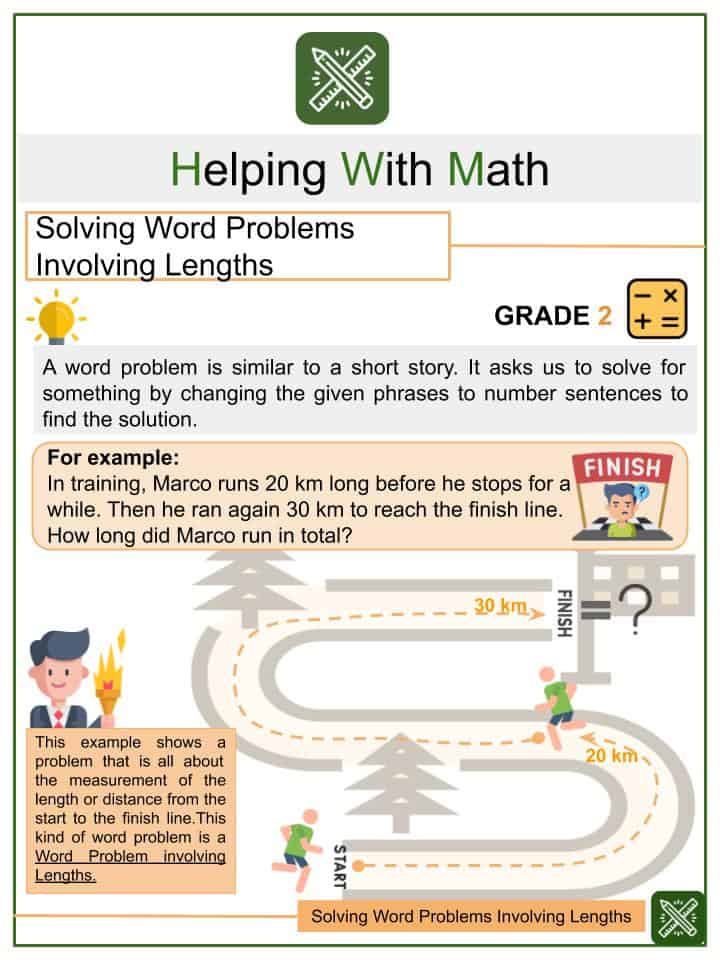
Download this Worksheet
This download is exclusively for Helping With Math Premium members!
To download this worksheet collection, click the button below to signup (it only takes a minute) and you'll be brought right back to this page to start the download!
Edit this Worksheet
Editing worksheet collections is available exclusively for Helping With Math Premium members.
To edit this worksheet collection, click the button below to signup (it only takes a minute) and you'll be brought right back to this page to start editing!
This worksheet can be edited by Premium members using the free Google Slides online software. Click the Edit button above to get started.
Download free sample
Not ready to purchase a subscription yet? Click here to download a FREE sample of this worksheet pack.
Definition:
A word problem is similar to a short story. It asks us to solve for something by changing the given phrases to number sentences to find the solution.
What should be know in solving for word problems ?
- What is given?
- What is asked?
- What operation should be used?
- What number sentence should be written
- What is the solution?
Steps to follow in solving word problems
- Read your problem carefully
- Draw a picture or a diagram
- Look for keywords as you read
- Write a number model or a number sentence
- Find the answer and write the correct unit
Janni brought 120 cm long cue before his training. After the training he realized that his cue is too long, so he brought 100 cm long cue on the next day of the training. What is the difference of first cue and the second cue?
- What is given? First Cue:120 cm Second Cue:100 cm
- What is asked? Difference of first and second cue
- What Operation should be used? Subtraction
- What number sentence should be written 120 – 100 = ?
- What is the solution? 120 cm – 100 cm = 20 cm
*The difference of first and second cue is 20 cm.
Solving Word Problems Involving Lengths Worksheets
This is a fantastic bundle which includes everything you need to know about Solving Word Problems Involving Lengths across 15+ in-depth pages. These are ready-to-use Common core aligned Grade 2 Math worksheets .
Each ready to use worksheet collection includes 10 activities and an answer guide. Not teaching common core standards ? Don’t worry! All our worksheets are completely editable so can be tailored for your curriculum and target audience.
Resource Examples
Click any of the example images below to view a larger version.
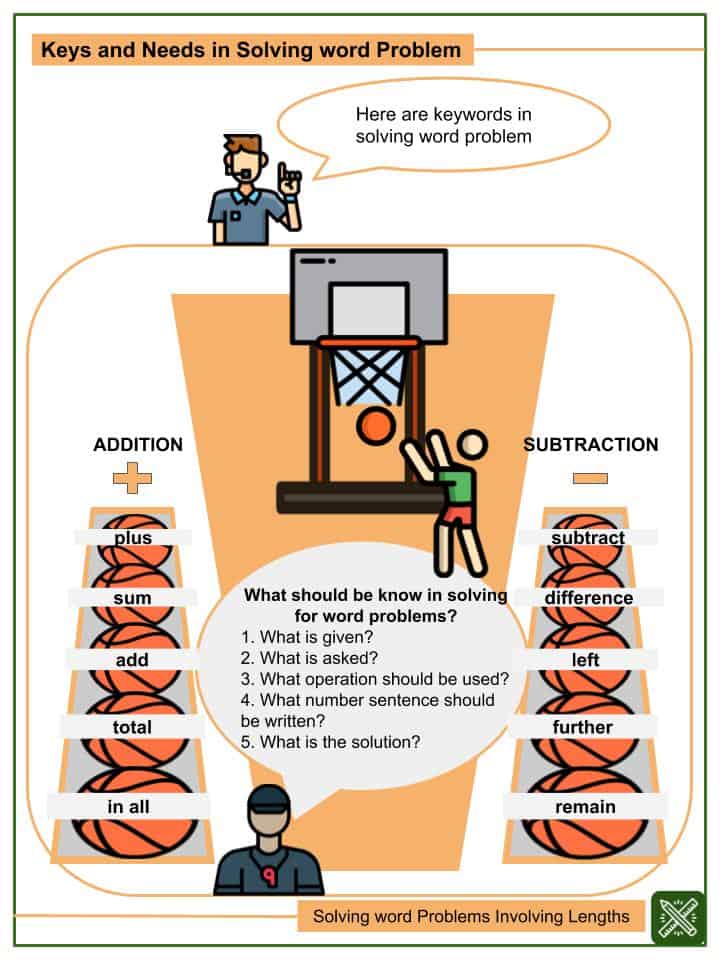
Even More Math Worksheets
- Solving word problems associated with Fractions 7th Grade Math Worksheets
- Solving Word Problems Involving Rational Numbers 7th Grade Math Worksheets
- Understanding Number Lines 2nd Grade Math Worksheets
- Solving Equivalent Fractions 3rd Grade Math Worksheets
- Odd and Even Numbers 2nd Grade Math Worksheets
- Comparing 3-Digit Numbers 2nd Grade Math Worksheets
- Solving Word Problems Involving Coordinate Plane 5th Grade Math Worksheets
- Word Problems Involving Comparison of Numbers Kindergarten Math Worksheets
- Understanding Basic Money Denominations 2nd Grade Math Worksheets
Lifetime Membership Offer
Exclusive, limited time offer! One payment, lifetime access.
While we continue to grow our extensive math worksheet library, you can get all editable worksheets available now and in the future. We add 100+ K-8, common core aligned worksheets every month.
To find out more and sign up for a very low one-time payment , click now!
Similar Worksheets
The worksheets listed below are suitable for the same age and grades as Solving Word Problems Involving Lengths 2nd Grade Math.
Multiplying Mixed Numbers by Fractions 5th Grade Math Worksheets

Dividing Mixed Numbers by Fractions 5th Grade Math Worksheets

July Free Bundle of Worksheets

Grade 1 Geometry Free Bundle

Grade 1 Measurement and Data Free Bundle

Grade 1 Operations and Algebraic Thinking Free Bundle

Grade 1 Number and Operations in Base Ten Free Bundle

June Free Bundle of Worksheets

Comparing Data Using “Less” and “More” 1st Grade Math Worksheets

Representing Data using Table and Charts 1st Grade Math Worksheets


IMAGES
VIDEO
COMMENTS
Luckily for length word problems, we don't have to remember any particular formula. We simply have to set up our equation where we add all the pieces on one side and the total length of the object on the other. First Piece + Second Piece = Total Length. Let's solve for [latex]\large{x}[/latex].
Length word problems. Otta, Elias, and Hans measured the lengths of their ladders. What is the length of Elias and Hans' ladders combined? Learn for free about math, art, computer programming, economics, physics, chemistry, biology, medicine, finance, history, and more. Khan Academy is a nonprofit with the mission of providing a free, world ...
These math word problems worksheets involve the measurement of length in both customary (inches, feet, yards) and metric (millimeters, centimeters, meters) units. No conversions of units between the two systems are needed. Inches, feet, yards: Worksheet #1 Worksheet #2. Mm. cm. meters: Worksheet #3 Worksheet #4. Mixed:
Videos, examples, lessons, and solutions to help Grade 2 students learn to use addition and subtraction within 100 to solve word problems involving lengths that are given in the same units, e.g., by using drawings (such as drawings of rulers) and equations with a symbol for the unknown number to represent the problem. Common Core: 2.MD.5.
Here centimeters are written as two digit number. Solved word problems on measuring length: 1. Sita is 1 m 30 cm tall and her sister Rita is 1m 60 cm tall. Who is taller and by how much? Rita is taller by 1 m 50 cm - 1 m 30 cm = 20 cm. 2. Maria purchased 24 m 25 cm rope and Nancy purchased 17 m 15 cm rope.
The measurement for the height of the wall is in metres, but the measurements for each child's height is in centimetres. So we need to convert the height of the wall from metres into centimetres ...
So 72 plus 14 is equal to, two ones plus four ones is six ones, seven 10s plus one 10 is eight 10s. So this longer line here is going to be 86, 86 centimeters. Let's do another one. So we're told a cable on the Golden Gate Bridge is 33 meters long. Another cable is 13 meters longer than the first cable.
Well, there is a bunch of ways that we can compute it. One way to do it is I could rewrite 85 as 80 plus 5, separate essentially the tens place from the ones place. We have 8 tens, which is the same thing as 80 and then 5 ones. And then rewrite 19 as 10 and 9. So if I'm subtracting 19, I'm really subtracting 10 and subtracting 9.
Videos and solutions to help Grade 2 students learn how to solve two-digit addition and subtraction word problems involving length by using tape diagrams and writing equations to represent the problem. Common Core Standards: 2.MD.5, 2.MD.6, 2.NBT.2, 2.NBT.4, 2.NBT.5 ... Problem Solving with Customary and Metric Units NYS Math Grade 2 Module 7 ...
This video lesson contains the MELC based Quarter 4 Week 4 competency in Mathematics 2. Watch and enjoy learning how to solve routine and non-routine word pr...
These word problems involve length and height and the addition / subtraction / multiplication or division of lengths measured in customary (inches, feet) and metric (centimeters, meters) units. No conversion of units is required. Worksheet #1 Worksheet #2 Worksheet #3 Worksheet #4. Worksheet #5 Worksheet #6. Similar:
K5 Learning offers free worksheets, flashcards and inexpensive workbooks for kids in kindergarten to grade 5. Become a member to access additional content and skip ads. Length word problems for grade 2. Simple addition and subtraction and / or comparison of lengths in word problem format. Separate worksheets for standard units (inches, feet ...
Number of problems found: 3075. Carol 3. Carol reduces the size of a photo by 30%. If the length of each side is 12 cm, what is the length of the side of the new photo? A rectangle 14. A rectangle is 8 cm long and 5 cm wide. Its perimeter is doubled when each of its sides is increased by x cm. From an equation in x find the new length of the ...
Measurements and Data. To solve length measurement problems, we need to have various factors in mind: the unit of measurement used, conversion exercises, and the understanding of how to use different measuring units. In this post, we'll present different exercise types that'll help us understand these concepts.
Resources tagged with: Length/distance Types All types Problems Articles Games Age range All ages 5 to 11 7 to 14 11 to 16 14 to 18 Challenge level There are 58 NRICH Mathematical resources connected to Length/distance , you may find related items under Measuring and calculating with units .
Length word problem (US customary) Woody has a lasso that is 11 ft long. Bo Peep has a lasso that is 23 ft longer than Woody's. How long is Bo Peep's lasso? Learn for free about math, art, computer programming, economics, physics, chemistry, biology, medicine, finance, history, and more. Khan Academy is a nonprofit with the mission of providing ...
Data can be collected to help solve a problem involving length. When we collect data, we need to decide which units to measure in: mm, cm or m. Representing data as a bar graph can help us interpret the data. Common misconception. Drawing tables and graphs from scratch can be tricky for some children.
Common Core For Grade 4. Videos, examples, solutions, and lessons to help Grade 4 students learn to use the four operations to solve word problems involving distances, intervals of time, liquid volumes, masses of objects, and money, including problems involving simple fractions or decimals, and problems that require expressing measurements ...
This problem involves area, and the unit used is one square plot. The area of the city block is 56, and the length of the block is 14. Substitute in the formula: 56 = w × 14. To solve this problem, you use the of , which is . Divide both sides by 14 to isolate the width. 56 14 = w × 14 14.
Solving Word Problems Involving Lengths Worksheets. This is a fantastic bundle which includes everything you need to know about Solving Word Problems Involving Lengths across 15+ in-depth pages. These are ready-to-use Common core aligned Grade 2 Math worksheets. Each ready to use worksheet collection includes 10 activities and an answer guide.
Solve application problems involving metric units of length, mass, and volume. Introduction. ... In the Summer Olympic Games, athletes compete in races of the following lengths: 100 meters, 200 meters, 400 meters, 800 meters, 1500 meters, 5000 meters and 10,000 meters. If a runner were to run in all these races, how many kilometers would he run?
Length word problems are questions written in paragraphs that provide a real life situation to solve.For example: Janine drove eighty meters to the shop, forty meters to the library, and then 11 metres back home. How far did Janine drive?This length word problem can be solved using mathematical calculations to find the distance Janine drove.
Module 2: Unit conversions and problem solving with metric measurement: Unit test About this unit "Module 2 focuses on length, mass, and capacity in the metric system where place value serves as a natural guide for moving between larger and smaller units."